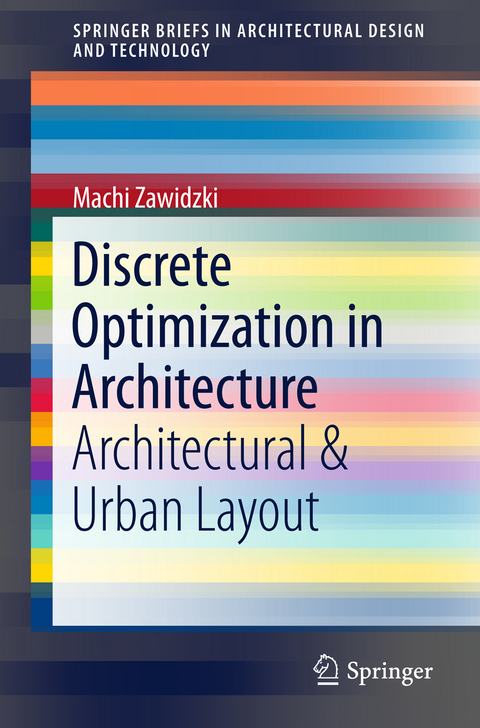
Discrete Optimization in Architecture
Springer Verlag, Singapore
978-981-10-1105-4 (ISBN)
This book presents three projects that demonstrate the
fundamental problems of architectural design and urban composition – the layout
design, evaluation and optimization. Part I describes the functional layout
design of a residential building, and an evaluation of the quality of a town
square (plaza).
The algorithm for the functional layout design is based on
backtracking using a constraint satisfaction approach combined with coarse grid
discretization. The algorithm for the town square evaluation is based on
geometrical properties derived directly from its plan.
Part II introduces a crowd-simulation application for the
analysis of escape routes on floor plans, and optimization of a floor plan for
smooth crowd flow. The algorithms presented employ agent-based modeling and
cellular automata.
Dr. Machi Zawidzki’s doctoral research focused on various optimization methods based on CI for the fundamental problems of the architectural design: Functionality, Structure and Aesthetics. His research interests are in designing built environment, especially in ergonomics and architectural design.
Quantization in Architecture & Urban Design: 1. Tessellation of space 1.1 Traditional grid/guideline systems (before the computer era) 1.1.1 Architecture 1.1.2 Urban Design 1.2 Modern (of the computer era) grid systems 1.2.1 "Collateral" systems, that is, derived from existing image pixelation 1.2.2. Space discretization serving optimization 1.2.3 Novel architectonic grid systems 1.2.3.1 Fine grid ("one cell = one agent") 1.2.3.1.1 Agent based modeling for crowd simulation 1.2.3.1.2 Simulation in regular tessellations: Square, Triangular & Hexagonal 1.2.3.2 Coarse grid ("cell side = minimal corridor width" ) 2. Discretization of Time 2.1 The role of time in architectural (and urban design?) 2.1.1 Crowd simulations 2.1.2 Daylight simulations 3. Module as a building component 3.1 Definition of a modular system and an overview of existing modular systems 3.2. Principles of two novel modular systems: Pipe-Z (PZ) & Truss-Z (TZ) 3.2.1 Deployability of PZ & TZ 4. Bringing it all together: Overview of the cellular automaton (CA) shading as a system with discrete time & space and realized with congruent modules. 4.1 Building Envelope and Daylighting 4.2 Why cellular automata (CA) to drive shading of building envelopes? 4.3 One-dimensional CA applied on surfaces 4.3.1 Various CA in square grid 4.3.2 Other regular tessellations: hexagonal and triangular 4.3.3 Rotating polarized film shading system 4.4 Two-dimensional CA on surfaces 4.4.1 Triangular CA 4.4.2 CA on triangulated free-form surfaces 4.5 Application of evolutionary algorithms for optimization of CA shading 4.6 Prototypes
| Erscheinungsdatum | 08.10.2016 |
|---|---|
| Reihe/Serie | SpringerBriefs in Architectural Design and Technology |
| Zusatzinfo | 82 Illustrations, color; 14 Illustrations, black and white; XIV, 105 p. 96 illus., 82 illus. in color. |
| Verlagsort | Singapore |
| Sprache | englisch |
| Maße | 155 x 235 mm |
| Themenwelt | Informatik ► Weitere Themen ► CAD-Programme |
| Naturwissenschaften ► Geowissenschaften ► Geografie / Kartografie | |
| Technik ► Bauwesen | |
| Technik ► Maschinenbau | |
| Schlagworte | Agent Based Modeling • Aggregate objective function • Architectural floor-plan • Backtracking • Bottleneck • Coarse Grid • constraint satisfaction problem • Crowd dynamics • Discrete Optimization • Distance potential field • Functional layout • Gridization • Grid rotation • heat map • Human subjective evaluation • Multi-objective • Pedestrian traffic • Regular (Platonic) tessellation • Square (Plaza) evaluation • Square triangular hexagonal grid |
| ISBN-10 | 981-10-1105-2 / 9811011052 |
| ISBN-13 | 978-981-10-1105-4 / 9789811011054 |
| Zustand | Neuware |
| Haben Sie eine Frage zum Produkt? |
aus dem Bereich


